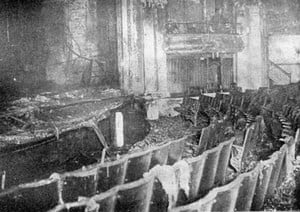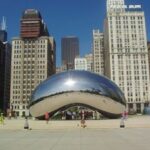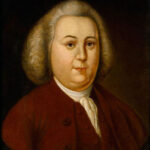The Iroquois Theater opened in downtown Chicago in November 1903. Located at 28 West Randolph between State and Dearborn, the theater’s opening had been long heralded in the press. The theater sat 1,724 people and its opening attraction was a vaudeville stage show called “Mr. Bluebeard” with citywide advertisements advising parents to “Don’t fail to have the children see “Mr. Bluebeard.” The added attraction was vaudeville comedian Eddie Foy as the star of the show. The theater was billed as a “completely fireproof structure” with extra exits for safety plus extra ushers and men in city uniforms at every show. In fact, the six-story tall Iroquois was described as a magnificent palace of marble and mahogany, a “virtual temple of beauty.” The theater was equipped with an asbestos curtain, which could be lowered to separate the audience from any fire on stage.
Tragically, with all the advanced press concerning safety, the Iroquois would become the site of one of the greatest fire tragedies ever one cold afternoon just five weeks after it opened.
Wednesday, December 30th was a typically brisk and cold Chicago winter day. People walked the streets at a quicker pace looking forward to New Year’s festivities and the hopes of what a new year would bring them. Children were out of school for the holidays and looking forward to an enjoyable matinee performance of “Mr. Bluebeard” at the Iroquois. Despite the seating capacity a recorded 1,900 people filled the theater to ‘standing room only’ that day, mostly young women and children.
The show began uneventfully as the crowd enjoyed the antics of Eddie Foy performing in drag followed by song and dance acts. After a short intermission the band began to play a number opening the second act. A chorus line appeared on stage dancing and singing when out of sight above the stage a canvas brushed against an arc light from a reflector causing a spark on the canvas. A stagehand positioned on a catwalk near where the fire started was unable to extinguish it. As embers hit the stage the chorus line tried stamping them out while continuing to perform. The orchestra, seeing the fire quickly gaining momentum, continued to play perhaps fearing a panic should they stop. The one trained fireman in the theater did not have the equipment to stop such a rapidly moving blaze.
Eddie Foy appeared on stage as spectators in the front appeared to be restless. He calmly reassured everyone that everything was under control when suddenly the canvas sceneries burned up in seconds causing its wooden skeletons to crash to the stage. Foy remained at the stage footlights attempting to keep the audience calm. He shouted for the stage manager to drop the asbestos based curtain and was ushered off the stage by his fellow cast mates. The curtain jammed when it snagged on a light fixture and the cast of the show ran to the stage door at the rear of the theater. This one act doomed the Iroquois Theater and many of its patrons.
As the door was opened the chilling Chicago wind blasted inside causing the fire on the partially lowered curtain to explode out into the audience as a giant swift fireball. Many of those found dead were still sitting in their seats, perishing before they even knew what hit them. Fires ignited on anything flammable but the major explosion blew itself out almost instantly.
Panicked patrons were left in the dark and realized the twenty-seven exits were not clearly marked making them difficult to locate. Once they did locate them they quickly discovered that iron gates inexplicably covered many of them. Some of them unlocked while others required being unlocked by a lever that untrained theatergoers could not use. Other doors opened inwards which only caused patrons up at the front to be crushed to death.
The stairwells from the balconies to the main floor were cluttered with bodies that survivors would climb over in the darkness unaware of the carnage before them. An alley fire escape caught fire causing patrons above the fire to leap out to the alley unaware they were leaping to their deaths. Those that followed were able to survive by using the dead as cushions. Patrons jumping from the balcony to the main floor had the same results.
Fifteen minutes after it started it was all over. Firefighters arrived and extinguished what was left of the blaze and then the unpleasant task of searching for survivors began. It became evident rather quickly that those who were still inside did not survive. Bodies that were already stacked in the stairwells remained there as other bodies were added the piles to keep out of the eye of the press and unwanted gawkers. Neighboring businesses transformed into makeshift hospitals and morgues.
602 people died that bitterly cold day in Chicago. Most of them were pre-teenage children and women. Only one performer from the show’s cast died and that was a tightrope worker who was hopelessly caught above the fire on stage. Amazingly enough the Iroquois body count was even higher then that of the Great Chicago Fire (250).
Who was to blame? The theater owners allowed almost 200 more people into the theater then allowed. Many city inspectors had family in the theater from “complimentary” tickets and may have overlooked certain fire code violations. The staff personnel had not been adequately trained for an event such as this and ended up not properly directing people as the panic began. It is believed they panicked as well and fled to leave the patrons to fend for themselves. All of this may have been prevented had the actors not opened the rear exit door but they were in a position where that was their only way out.
In the end there was a sensational trial that dominated newspaper headlines throughout the country. The theater owners, building owners, city inspectors and even Mayor Carter Harrison were indicted but no one was ever convicted due to legal technicalities. The only person ever convicted of anything to do with the events of that day was a business owner who was caught robbing valuables from the dead.
After the trial Mayor Harrison shut down every theater, hall and church to be re-inspected forcing the dismissal of over 6,000 people. New city codes were established to require all exit doors open outward, be clearly marked, and have fire curtains made of steel. All personnel were required to be trained so a tragedy like this would never happen again.
Sadly, none of the injured who survived or the families of the deceased received any financial damages for their loss or injury.
The Iroquois ended up with only minor interior damage and would re-open less then a year later. Theater owners wisely decided to distance themselves from the tragedy and renamed the theater The Colonial, which was torn down in 1926. The Oriental Theater was built on the site of the Iroquois and still stands today as the Oriental Theater Ford Center for the Performing Arts. Like its predecessor the Oriental is now home to live stage shows.







